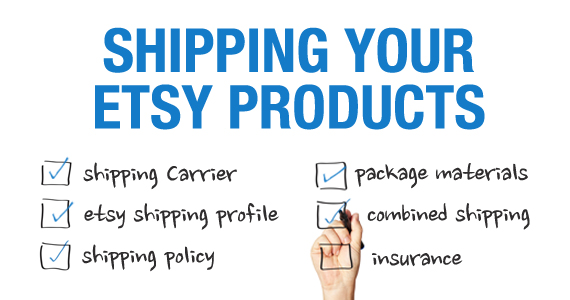 When it comes to unique or lovingly handcrafted merchandise, there’s no place like Etsy. Of course, such precious cargo deserves extra consideration for shipping. Ensure your items make the trip safely and arrive in tip-top shape at their destination by remembering these shipping tips.
When it comes to unique or lovingly handcrafted merchandise, there’s no place like Etsy. Of course, such precious cargo deserves extra consideration for shipping. Ensure your items make the trip safely and arrive in tip-top shape at their destination by remembering these shipping tips.
Choosing a Carrier
With the three major U.S. shipping carriers offering options at many different price points and delivery times, you’re sure to find a solution that meets all your criteria. Here’s a quick look at the basics of each carrier.
- United States Postal Service (USPS). The USPS is the most economical choice for small and lightweight (under 5 pounds) packages. For heavier items, the USPS offers Priority Mail Flat Rate (up to 70lbs.) and Regional Rate (up to 25 lbs.) options. Use your local post office, or enjoy at-home convenience plus discounted postage rates when you print shipping labels online via a service like Stamps.com.
- UPS. If you’re mailing large or heavy items that won’t fit in USPS Flat Rate boxes, consider shipping with UPS. This shipping carrier offers many different delivery times and has great rates for heavy and oversized packages. Visit http://www.ups.com.
- FedEx. If you’re shipping something expensive, perishable or otherwise time-sensitive, FedEx is the recognized name for overnight service – but the faster your buyer needs it, the more it will cost. Visit http://www.fedex.com/us.
Create Your Etsy Shipping Profile
With an Etsy Shipping Profile, automatically apply your shipping preferences to your item listings, especially if your products are of similar size and ship for the same cost. It saves time during the checkout process and prevents surprises for your customers.
To create your Shipping Profile, go to your account page and click Create a New Profile and name it, according to the product (such as “Leather Bracelet Shipping”). Choose a processing time and the country from where you’re shipping, plus the add-on amount to ship it with another item, if applicable. Specify your destination country or countries, then click Create Shipping Profile to save.
Set Your Shipping Policy
One of your most important Etsy business decisions is your shipping policy. When you’re an e-commerce seller, shipping is more than just a means of getting goods to a destination – it’s also one of the most important elements of customer service. Spend some time researching your carrier options, weighing the pros and cons for each method. Perhaps you’ll find a mix of the choices to be right for your business, especially if your products range widely in size, weight and value.
Buyers pay attention to shipping choices. State upfront what your policies are on the following:
- How often you ship. Daily? Weekly? Within 24 hours of receiving payment? Choose a schedule and keep to it.
- What carrier(s) you use. Your choice has to be right for you, but keep in mind that not all carriers cover all areas. UPS, for example, cannot ship to P.O. boxes and requires a physical address.
- Delivery confirmation and insurance. Is it included in your shipping or handling fee? Is it an option buyers can pay extra for? Or are you paying for these services out of the product cost?
- Processing time. Even if your Etsy shop is a sideline, you still need to treat it as the business it is, and that means fulfilling and shipping orders promptly. Buyers appreciate knowing the leadtime – if any – they’ll need to add to the shipping timeframe, especially around the holidays and for perishable items.
- Rush or expedited orders. Oftentimes, going the extra mile in terms of customer service makes a big difference in establishing strong seller-buyer relationships. Consider offering rush or expedited shipping under special circumstances, or as a paid option for buyers for even more flexibility on both ends of the transaction.
Your Shipping Center
Having all your shipping paraphernalia handy at all times will help make the process automatic and keep your orders on track. Set aside some space for the following shipping must-haves:
- Postal scale for determining package weight and comparing shipping rates
- Packing material, such as packing peanuts, tissue paper and bubble wrap
- Packing tape, preferably in a tape gun so you don’t waste precious moments finding the cut end on the roll
- Boxes in a variety of sizes – don’t forget the USPS provides Priority Mail boxes free of charge
- Shipping labels, plus fragile/perishable stickers if applicable
- Extras, such as care instructions, that help your buyer use or care for your product, plus business or note cards for that personal touch
Will You Ship Internationally?
Selling and shipping internationally on Etsy opens your business to a worldwide customer base, which can mean great things for your exposure and bottom line alike.
Don’t be stymied by the differences between domestic and international shipping – Etsy walks you through the process, and we’ve summarized the most common questions and concerns right here on eCommerceWeekly. Some sellers choose to start with other English-speaking countries like Canada and the United Kingdom and then branch out as their global-shipping and -selling comfort level increases.
Combined Shipping
Everyone loves a bargain … and if it garners more sales for you, all the better, right? Put some thought into offering a discounted rate on combined shipments.
If you choose to offer combined shipping, remember to enter both primary and secondary shipping costs on all items; the secondary cost is the additional amount it will cost to ship the item along with another item. For example, the primary shipping cost of a sweater might be $6.95, while the secondary shipping cost could be $2.95. For two sweaters, your buyer will be paying $9.90 total, which represents a savings of $4.00. Of course, if your shop includes products of different price points as well as shipping, you will need to include language to make it clear to the buyer that the highest primary shipping cost will apply for the first item.
Package Insurance
As a seller, you have a lot of time and effort invested in your handcrafted products. If an item is broken in transit, you lose out on time it took to create the product plus the shipping cost. For a small business, the impact could hit you hard, so look at insurance as a great way to help cover your costs.
Insurance protects both buyer and seller from loss, theft or damage of your shipment, and handling disputes is much easier when insurance has been offered upfront. It should be a must for high-ticket items, but it’s also a good idea – and simply good business – to offer even a small amount of insurance on every package.
All carriers offer extra insurance. As you compare prices, don’t forget to factor in insurance as you formulate your preferred methods and price points.
What About “Free” Shipping?
Of course, shipping is never really “free” – but it’s something to consider as a promotion. You’ll need to carefully price your items so you don’t lose your shirt on the deal. Steer clear of blanket free-shipping policies that could include low-priced items in which the product cost may be completely eaten by your “freebie” offer. Another idea: Offer it as a VIP benefit to loyal customers, or with large-volume orders. Find detailed information on free shipping right here on eCommerceWeekly.






